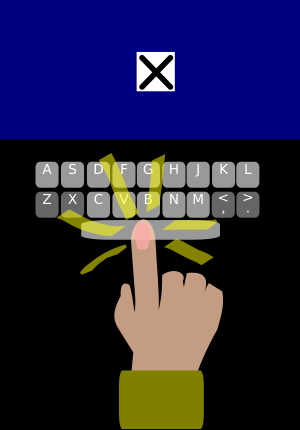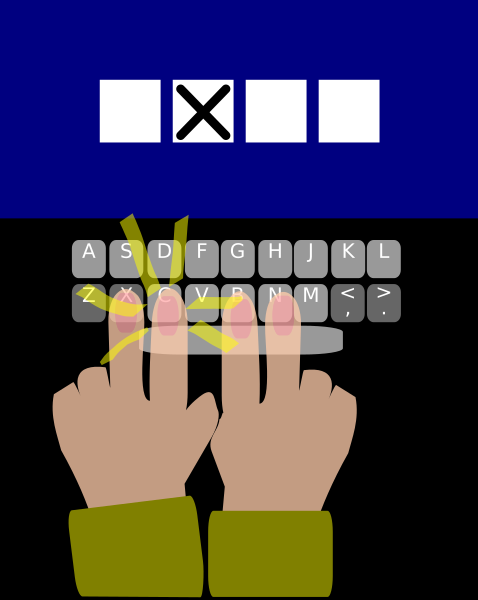Introduction
In cognitive experimental psychology, we distinguish between simple and choice response time tasks. These two terms are being used in many books papers about cognitive psychology. This lesson explains and demonstrates what we mean with simple and choice response time tasks.
| Type | Definition | Examples |
|---|---|---|
Simple Response Time task (SRT) |
There is just one stimulus, and when it appears, you need to respond with the one response there is in this type of experiment |
Every time you see a light go on, you need to press the space bar of your computer keyboard. Or the athlete starting to run when the starting gun goes off. |
Choice Response Time task (CRT) |
There are multiple stimuli, and each stimulus requires a different response |
You will see one of 10 letters presented. Each time you see the letter, you need to press the corresponding letter key of your keyboard. |
People (and animals) can respond a lot faster when there is just one stimulus and one response type (Simple Response Time task). Also, the more stimuli and responses there are, the slower you get (this is known as Hick’s law).
| Generally speaking, when there is just one stimulus and one response, many people can respond well below 200 ms, that is less than 1/5th of a second! In choice response time tasks with 2 stimuli and 2 responses (that is the simplest possible choice response time task), responding within 250 ms is probably the fastest you can do, but more typically people have an average response somewhere between 350 and 450 ms. Again, a multitude of factors can influence this, including the exact type of stimulus and response mode. |
It is now well established that a person’s response speed is influenced by age and general intelligence (e.g., Deary, Liewald, and Nissan, 2011). It is important to note that many other factors play a role as well, for example the conditions under which you perform the task (are you fit or tired, are you hungry, etc). Also, your speed depends on how accurate you aim to be. If you do not want to make mistakes, you will become slower. This is known as the speed-accuracy trade off (this goes back to the work of Woodworth, 1899; for a good review see Heitz, 2014).
It is important to understand that response times play a crucial role in experimental cognitive psychology. The basic idea is that response times reflect the time it takes to interpret a stimulus, get information from memory, initiate a muscle response, etc. Thus, response times can be used to find out how long basic thought processes take. This idea goes back to the work of the early experiment psychologists in the second half of the 19th century (when the term "cognitive psychology" did not even exist). One of the leading figures in this area of research was the Dutch ophthalmologist Franciscus Donders.
In pictures
Below you see an example of the simple and the choice response time paradigm.
In the simple reaction time task, you need to wait until you see a black cross on the white square. When that happens, you press as soon as you can the space bar. Thus, there is one stimulus (black cross) and one response (pressing the space bar).

In the choice reaction time task, you need to wait until you see a black cross on one of the four white squares (e.g., there are four different black cross position, which counts as four different stimuli). When that happens, you press as soon as you can the corresponding key (z, x, . or ,). Thus, there are four stimulus-response associations. In this example trial, you need to press the "x" key.

Do it yourself
In the demonstration below, you will do both a simple response time task (20 trials) and a choice response time task (20 trials). At the end, you will see your average response speed for the simple and choice reaction time task. You will be slower in the choice reaction time task.
Here we use the Deary-Liewald paradigm, which uses both a simple and a 4-choice response time task. There are two differences:
-
In the original Deary-Liewald paradigm, there are training blocks and more trials than in this demo.
-
In the original Deary-Liewald PC version, the keys of the keyboard chosen are great for UK and US keyboards, but not for German and French keyboards. This implementation uses x, c, b, and n because that works on UK, US, German, French keyboards, and probably cover most keyboards around the world.
If you want to do the full version of the Deary-Liewald paradigm, visit the experiment library.
| The time between stimuli varies (randomly) between 1 and 3 seconds. This is an important part of the paradigm. If this random variation would not be used, the simple choice reaction time task would be very simple, because you could predict when the stimulus would appear. |
References
-
Deary, Liewald & Nissan (2011). A free, easy-to-use, computer-based simple and four-choice reaction time programme: The Deary-Liewald reaction time task. Behaviour Research Methods, 43, 258-268.
-
Heitz, R. P. (2014). The speed-accuracy tradeoff: history, physiology, methodology, and behavior. Frontiers in Neuroscience, 8, 1-19.
-
Woodworth, R. (1899). The accuracy of voluntary movement. Psychological Review, 3, 1-106
